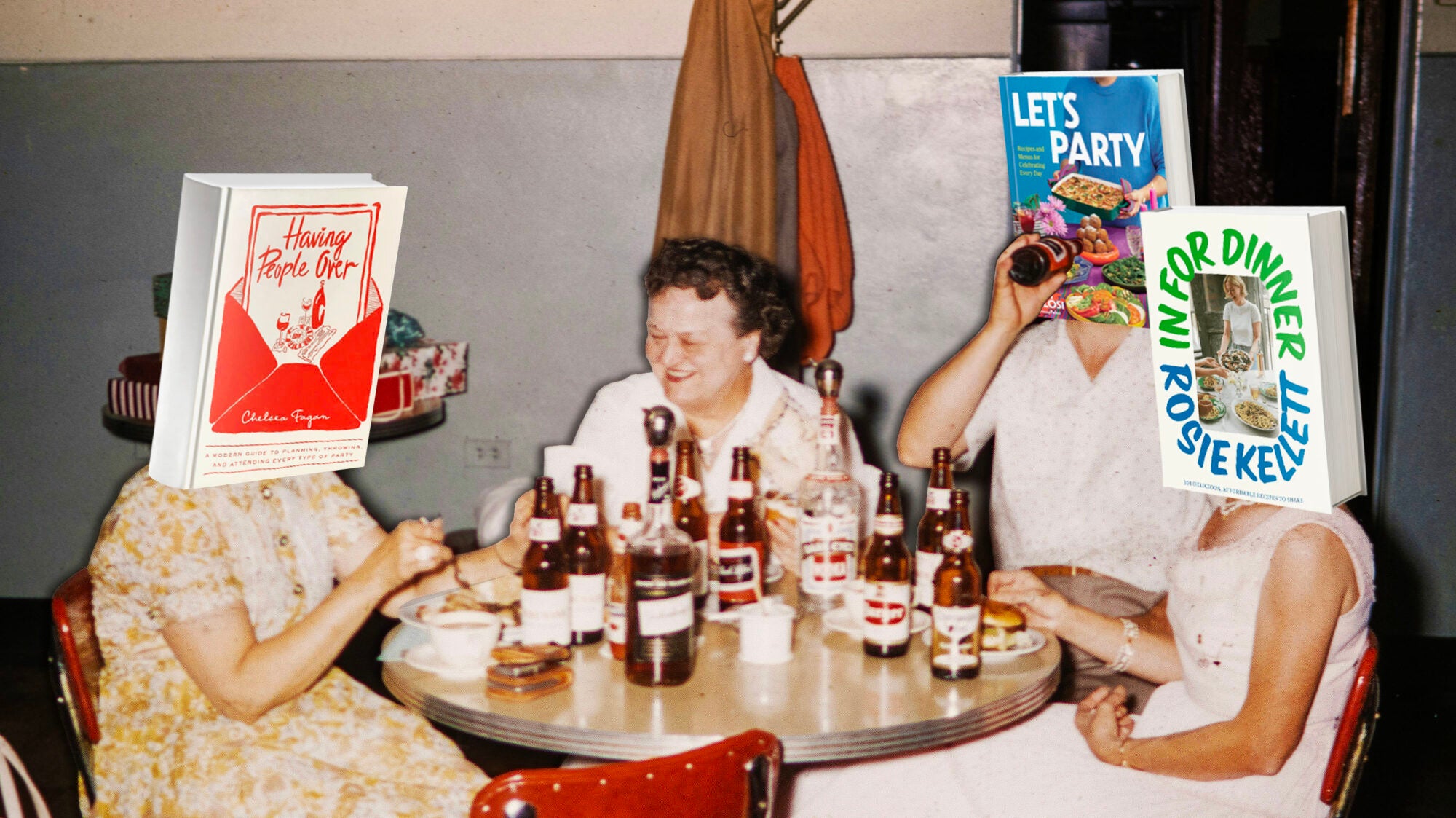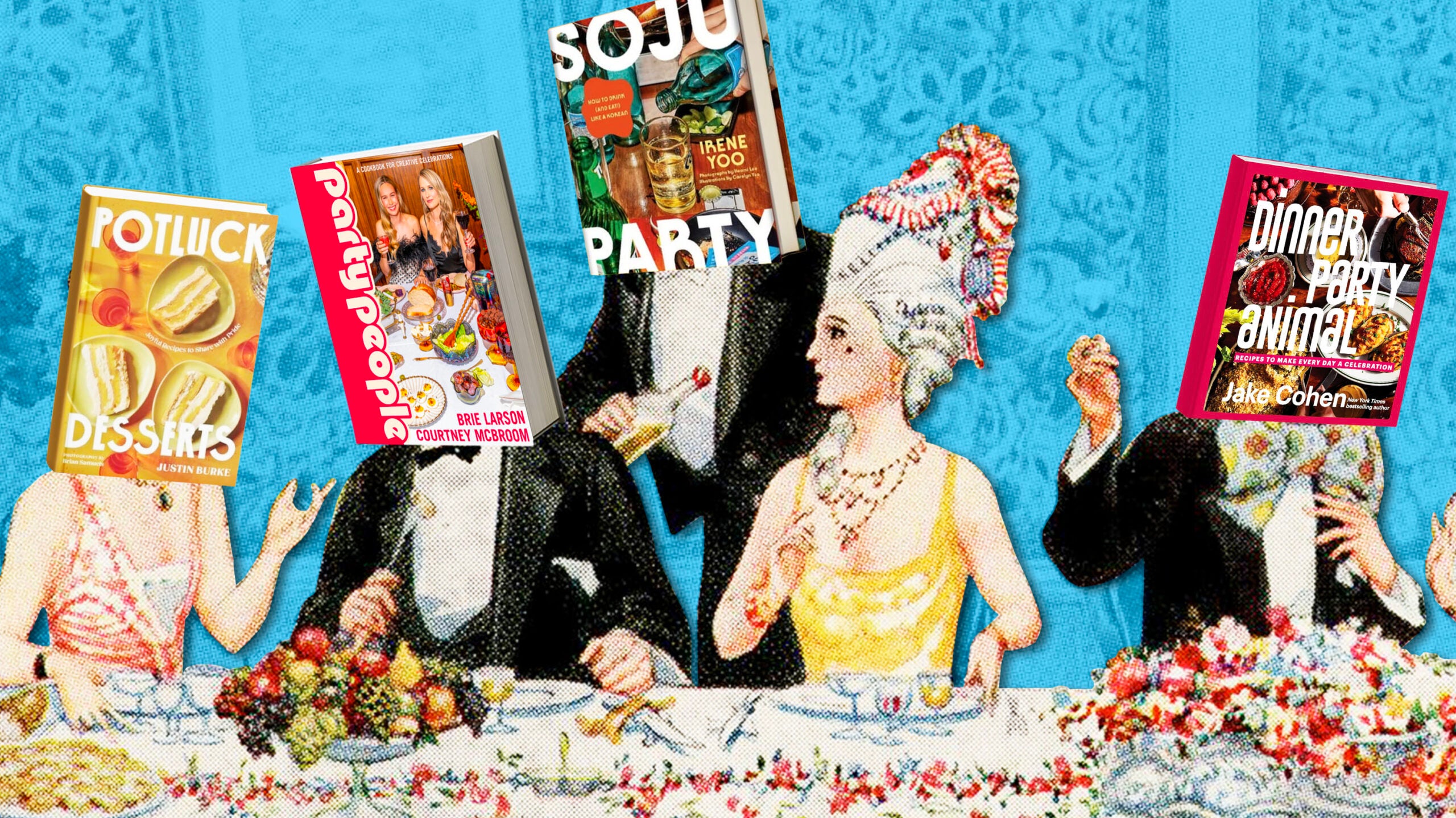
A new wave of cookbooks—plus an iconic Martha reissue—is showing how to cook for and host a crowd.
In 1982, Martha Stewart taught everyone how to throw a party. Her first book, Entertaining, was a break from the stuffy, prescriptive guides of previous generations. Written with the sage wisdom of a battle-hardened Connecticut caterer (and model, and stockbroker), Martha insisted that throwing a good party is as simple as “the desire to please someone in a personal way.” That could mean whipping up 30 omelets at midnight after seeing Cats on Broadway, a 14-course luau complete with a full suckling pig on a spit in your backyard, or a meticulously planned wedding with “borrowed heirloom silver serving trays from friends and relatives.” (Sure!) The book included not just recipes but menu plans, party prep timelines, and decorating tips, and while it still catered very much to the WASPy New England crowd, the point was that all that money, craft, and beauty should be in service of fun.
Perhaps this all sounds retro—the food, yes, but also the gatherings themselves. If the mainstream media is to be believed, we are not socializing like we used to. Face-to-face time is down; people are spending more time alone, and when they do socialize, it tends to be mostly with the people they already live with. About one in eight Americans says they have no close friends with whom to even throw a party. “America is in a party deficit,” argues Ellen Cushing in the Atlantic. “We are obligated to create the social world we want.” So if we want to stop feeling lonely, isolated, and disconnected, we need to throw some parties. And this fall, cookbooks are here to help.
On November 4, Clarkson Potter is reissuing Martha’s Entertaining, reaffirming that 43 years later, it “will ensure that you never run out of ideas or inspiration for hosting the perfect event.” But this time, Martha has some competition. There’s Dan Pelosi’s Let’s Party, featuring 16 dinner party menus for any possible occasion; Having People Over by Chelsea Fagan, a guide to being the perfect host; Dinner Party Animal by Jake Cohen; and Party People by actress Brie Larson and Courtney McBroom; with Party Tricks by former TASTE editor Anna Hezel arriving next spring. These come on the heels of Potluck Desserts by Justin Burke and In for Dinner by Rosie Kellet. There are also party-adjacent books, like Good Things by Samin Nosrat, Linger by Hetty Lui McKinnon, and Soju Party by Irene Yoo, which still focus on gathering even if they don’t give you a formal menu plan.

Does a party recipe really read that differently than any other recipe? “Entertaining is a good hook, and it gives you a way to craft a narrative, but there’s not generally a meaningful distinction between a recipe that’s written for a party and one that’s written for any other purpose,” says Tom Pold, senior editor at Knopf and the editor of Soju Party. After all, plenty of books already give you recipes for dishes that serve six to eight people. But there are some thematic through lines in these party cookbooks that set them apart.
There are recipes for batched cocktails, for salty snacks and dips, and for every version of a roast chicken you can imagine. But there are also guides for setting the table (“the difference between eating dinner and having a dinner party is a tablecloth,” says Pelosi in Let’s Party), planning a schedule (“the night before a party is all about cleaning,” says Fagan in Having People Over), lighting (overhead is a no-no, per Larson in Party People), and even figuring out which guests to invite (“always save a seat for someone who likes to gossip,” recommends drag queen Juanita MORE! in a cameo in Let’s Party). And everywhere there are overexposed photos of teeth glistening, mouths wide open, laughing or anticipating the next bite.
When Pelosi sat down to write Let’s Party, he realized gathering was so intuitive to him that he almost didn’t recognize his dinner parties for what they were. “I get comments from folks in my life like, ‘Wow, you’re always throwing a party.’ I was like, ‘That’s not a party. That’s just how I live my life,’” says Pelosi. For him, the format of set menus was just an easier way to communicate his general thought process—how to pair recipes, how to plan ahead, how to make sure something’s always ready in case a guest shows up unannounced. Ideally, it’ll all “help you understand how this can just become part of your life.”
Anna Hezel says she got the idea for Party Tricks after seeing what readers responded to in her previous two cookbooks, which were focused on lasagna and tinned fish. “Those tended to offer recipes that you could easily throw together and that were impressive enough to serve to friends, but also easy enough if you’re just having a snacky dinner at home,” she says. She credits this to the proliferation of high-quality direct-to-consumer and store brands like Fishwife and Omsom. This means home cooks can pick up a few premade ingredients to prepare a recipe that’s both semihomemade and truly impressive. A baked local cheese drizzled with small-batch olive oil, a frozen puff pastry filled with $13 tinned fish and farmers’ market produce, and you’re set.
The most prominent similarity among these books might be how they attempt to justify their own existence, declaring that parties aren’t just fun but essential. “In a culture that is increasingly estranged from itself, with communities fraying at the edges, gathering is an important act,” writes Fagan. Larson and McBroom argue that “people have partied since the beginning of time,” before referencing statistics on modern loneliness and citing Carl Jung. “We need to feel seen, heard, and understood by those we care about in order to combat loneliness,” they write. “One of the best ways to do that is to throw a party.”
The most prominent similarity among these books might be how they attempt to justify their own existence, declaring that parties aren’t just fun but essential.
They’re not wrong. Yes, it’s true that humans need to gather. But if hanging out is human nature, do we need to be reminded to do it? Maybe we do. “I think we all were like, ‘We’re never gonna hang out,’” says Justin Burke of COVID lockdowns. “All these books coming out were pitched during 2020 and 2021, when we were hungry for gathering.” For him, gathering has extra meaning; his cookbook, Potluck Desserts, was inspired by queer potlucks, a lifeline for many ostracized by their birth families, where you can share a family recipe with people who are more willing to accept you for who you are. Plus, you can just relax. “I think we’re empowered to cook at home and not to believe that everything has to be social-media-ready,” he says.
Home is also increasingly the only place where these gatherings can happen. “Restaurants are getting more and more expensive, and it’s dovetailing with this moment when our standards for how food should look and taste are so high,” says Hezel. A night out with multiple cocktails and shared plates might just be out of the budget, but that doesn’t matter as long as you have a pitcher of Paper Planes, whipped feta dip, and a tray of lemon bars on deck.
At the beginning of her book, Fagan describes the act of hosting as a “ritual” through which to share the “intimate, beautiful tedium of your life.” Like any ritual, it needs to be practiced. Even if the desire to gather has been coursing through us since we were gossiping about cave art, we need reminders that doing so may take some forethought, some decoration, and some scrubbing of the toilets. But ta-da! There’s the laughter, the sharing of recipes, the lazing on the couch with your most precious friends over just one more glass of punch. The trick is remembering that this is what it could always be like.